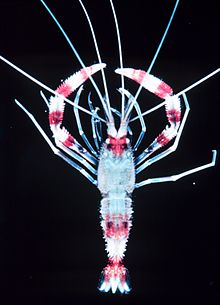Stenopodidea
| Stenopodidea Temporal range:
| |
|---|---|

| |
| Stenopus hispidus | |
| Scientific classification | |
| Domain: | Eukaryota |
| Kingdom: | Animalia |
| Phylum: | Arthropoda |
| Class: | Malacostraca |
| Order: | Decapoda |
| Suborder: | Pleocyemata |
| Infraorder: | Stenopodidea Claus, 1872 |
| Families | |
| |
The Stenopodidea or boxer shrimps are a small group of decapod crustaceans. Often confused with Caridea shrimp or Dendrobranchiata prawns, they are neither, belonging to their own group.
Anatomy
They can be differentiated from the Dendrobranchiata prawns by their lack of branching
Taxonomy
Stenopodidea belongs to the
| Decapoda |
| ||||||||||||||||||||||||
There are 71 extant species currently recognized within Stenopodidea, divided into 12 genera.[3] Three fossil species are also recognized, each belonging to a separate genus.[4][5] The earliest fossil assigned to the Stenopodidea is Devonostenopus pennsylvaniensis from the Devonian.[5] Until D. pennsylvaniensis was discovered, the oldest known member of the group was Jilinicaris chinensis from the Late Cretaceous.[6]
The cladogram below shows Stenopodidea's internal relationships:[2]
| Stenopodidea |
| ||||||||||||
Stenopodidea comprises the following families and genera:
- MacromaxillocarididaeAlvarez, Iliffe & Villalobos, 2006
- Macromaxillocaris Alvarez, Iliffe & Villalobos, 2006
- Spongicolidae Schram, 1986
- Engystenopus Alcock & Anderson, 1894
- Globospongicola Komai & Saito, 2006
- Jilinicaris † Schram, Shen, Vonk & Taylor, 2000
- Microprosthema Stimpson, 1860
- Paraspongicola De Saint Laurent & Cléva, 1981
- Spongicola De Haan, 1844
- Spongicoloides Hansen, 1908
- Spongiocaris Bruce & Baba, 1973
- Stenopodidae Claus, 1872
- Devonostenopus † Jones et al., 2014
- Juxtastenopus Goy, 2010
- Odontozona Holthuis, 1946
- Phoenice † Garassino, 2001
- Richardina A. Milne-Edwards, 1881
- Stenopus Latreille, 1819
References
- ISBN 978-0-8061-3555-7.
- ^ PMID 31014217.
- ISBN 978-90-6519-200-4. Archived from the originalon 2012-12-20.
- Raffles Bulletin of Zoology. Suppl. 21: 1–109.
- ^ doi:10.1666/13-059.
- .
